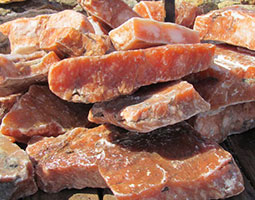Description

Soapstone is a metamorphic rock that is composed primarily of talc, making it very soft, and varying amounts of chlorite, micas, amphiboles, carbonates, and other minerals. Soapstone is typically grey, bluish, green, or brown in colour whilst its name is derived from its 'soapy' feel and softness. Soapstone often forms at convergent plate boundaries where broad areas of Earth’s crust are subjected to heat and directed pressure.
People have quarried soapstone for thousands of years. Native Americans in eastern North America used the soft rock to make bowls, cooking slabs, smoking pipes, and ornaments as early as the Late Archaic Period (3000 to 5000 years ago). The people of Scandinavia began using soapstone during the Stone Age, and it helped them enter the Bronze Age when they discovered that it could be easily carved into moulds for casting metal objects such as knife blades and spearheads.
Uses
The special properties of soapstone make it suitable, or the material of choice, for a wide variety of uses such as:
- Countertops in kitchens and laboratories
- Sinks
- Cooking pots, cooking slabs, boiling stones
- Bowls and plates
- Cemetery markers
- Electrical panels
- Ornamental carvings and sculptures
- Fireplace liners and hearths
- Woodstoves
- Wall tiles and floor tiles
- Facing stone
- Bed warmers
- Marking pencils
- Moulds for metal casting
- Cold stones
Sources